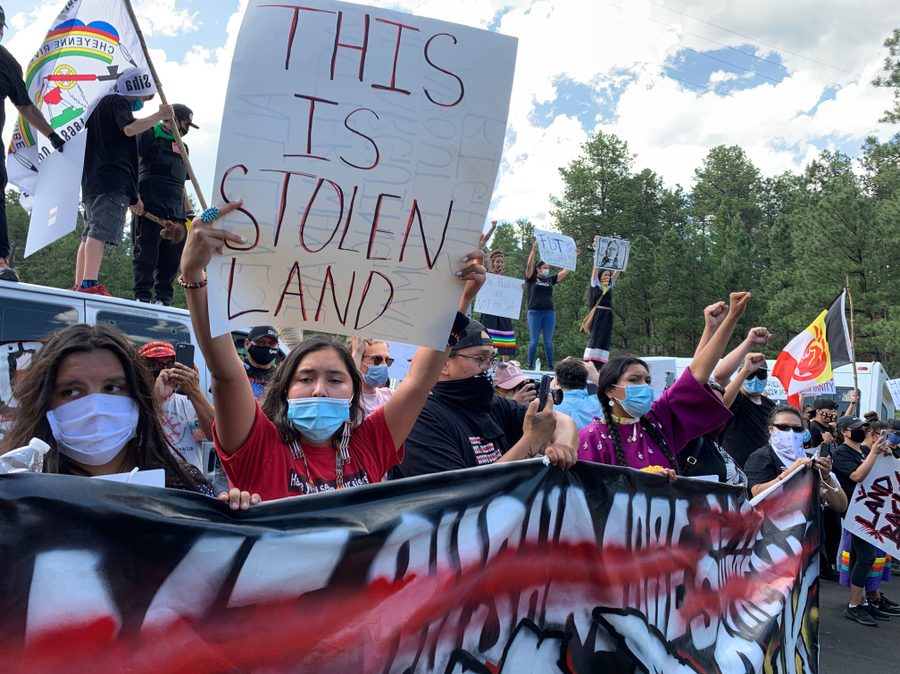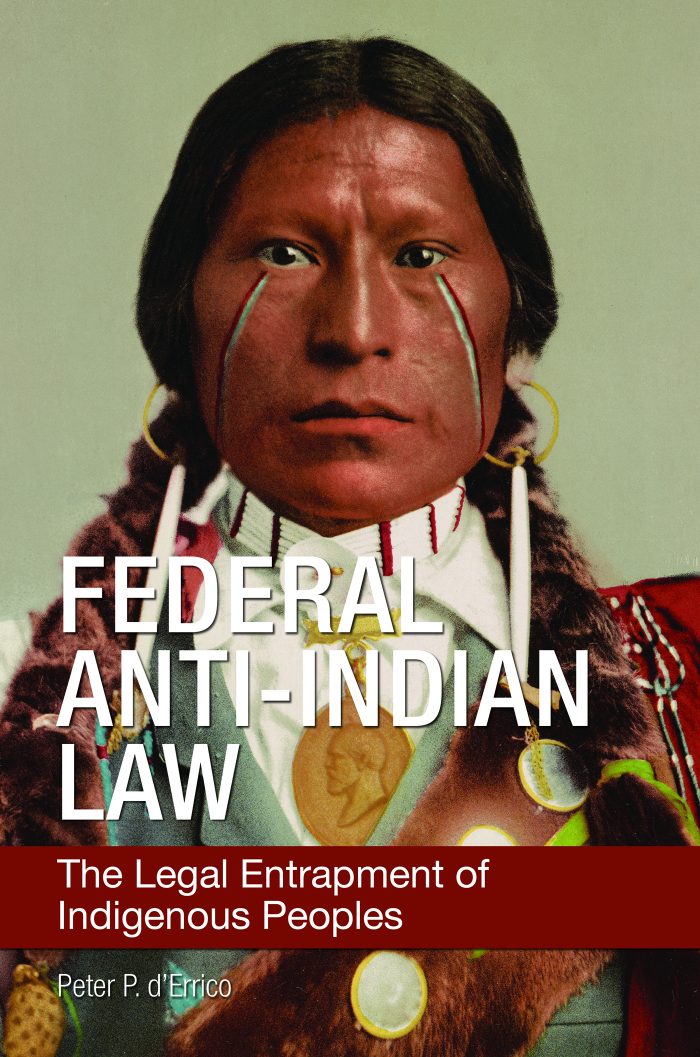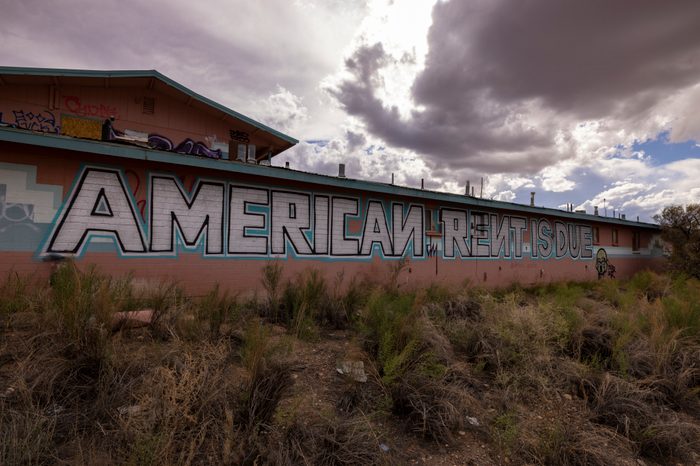Shaky Ground: How the United States Uses the Law to Steal Indigenous Land
A review of Peter d’Errico’s Federal Anti-Indian Law: The Legal Entrapment of Indigenous Peoples, an indictment of a legal system with the unflinching goal of stealing as much land as possible.
Stephanie Woodard

In Federal Anti-Indian Law: The Legal Entrapment of Indigenous Peoples, Peter d’Errico exposes the capriciousness and hostility with which the United States uses the law to apply — or deny — justice to the original peoples of this land.
“When we enter a realm called ‘federal Indian law’ … we are entering a semantic world created by the United States to control Native peoples and claim their lands,” writes d’Errico, an attorney and professor emeritus at the University of Massachusetts-Amherst.
Despite its confusion and contradictions, federal Indian law — in d’Errico’s terms, “anti-Indian law” — has long had an unchanging purpose. By destroying Native individuals and communities, it has helped the rich and powerful scoop up vast lands and resources. This landgrab is accomplished in part because what’s typically called federal Indian law is hardly a systematic set of statutes. Instead, according to d’Errico, it’s what mid-20th-century U.S. Supreme Court Justice Felix Frankfurter called “a vast hodge-podge” and covers all areas of Indigenous life and activity with a massive array of U.S. court decisions, laws, executive orders and agency regulations that have piled up over the years in a disorderly and improvised fashion.
Kent McNeil, a professor emeritus at Osgoode Hall Law School at York University in Toronto, calls d’Errico’s Federal Anti-Indian Law “a frontal attack on the whole field of American law pertaining to Indigenous peoples.” He lauds it as a “must-read” for those wanting to understand what motivates any claims that the dispossession of Indigenous people has been legally sound. Similarly, Robert Maxim, a senior research associate at the Brookings Institution and a Mashpee Wampanoag tribal citizen, hails the book as “important and enlightening for all people, Indigenous and non-Indigenous alike.”
Throughout the chaos, the application of U.S. law to Indigenous people has had an unflinching goal: theft.
By marginalizing Indigenous peoples and their rights under their treaties — and, since 1924, as full citizens of the United States — federal anti-Indian law has served the rich and powerful. These include the earliest American leaders. George Washington, Thomas Jefferson and many others profited handsomely. And they knew they had to work fast: According to Washington, anyone “who neglects the present opportunity of hunting out good lands … will never regain it.”
The United States, writes d’Errico, is “a land office business,” all about profiting off land. Or, as Washington warned: You snooze, you lose.

Our first president’s maxim is still true today. When I wrote “How the U.S. Government Is Helping Corporations Plunder Native Land” for In These Times in 2016, the article was about a Navajo family that was struggling to shut down an oil pipeline that had been crossing its land for decades. Meanwhile, non-Native companies and individuals throughout Indian country were profiting off Native land to the tune of billions of dollars as they grazed animals, planted crops, felled timber, dug up minerals, extracted oil and gas and more.
D’Errico’s writing is informed by his experiences starting in the late 1960s as an attorney for the primarily Navajo clients of the nonprofit legal service, Diné be’iiná Náhiiłna be Agha’ diit’ahii, which was located on the Navajo Nation at the time. He continues to this day to litigate Indigenous cases, including on behalf of Native prisoners’ freedom of religion, Mashpee Wampanoag fishing rights and Western Shoshone land rights. A graduate of Yale Law School, he co-founded the legal studies department at UMass-Amherst and taught there for 30 years.

The Supreme Court has long provided legal cover for those who wish to wrest land and resources from Indigenous peoples. In the early 1800s, the court declared in three opinions—Johnson v. McIntosh, Cherokee Nation v. State of Georgia and Worcester v. State of Georgia—that Native peoples did not, in fact, own their land but were mere “occupants” if Christians had “discovered” it; that Native nations were “wards” of the United States; and that the United States had “ultimate dominion” over all Native land and peoples.
The opinions’ primary author was Chief Justice John Marshall. A devout Christian, he ignored the Constitution’s imperative to separate church and state. He pointed to Christianity as the rationale for dominion and — after religious conversion of “heathen” Natives — the compensation for their losses.
Marshall knew he was on shaky ground. D’Errico quotes him conceding that the claims of one opinion were “pretensions” that existed “nowhere else.” This was not ordinary law, but the suspension of law, d’Errico says. Marshall had carved out an exception to property law, proclaiming that Natives, as inferior people, had “diminutive rights”: They might inhabit land but did not own it.
The opinions had an historical model. Fifteenth-century papal bulls directed Christian monarchs to “invade, conquer, fight, subjugate” lands owned by non-Christians and reduce the inhabitants to “perpetual servitude.” The bulls described colonization as a transaction: salvation for those Christians who contributed money or combat skills and excommunication for those found taking anything “except expenses and salaries.” The bulls also described map coordinates establishing which nations owned what discovered, or “hitherto undiscovered,” land.
In March 2023, the Vatican tried to wriggle out of accountability for colonization’s devastating and ongoing effects on Native communities. Two Vatican departments — for Culture and Education and for Promoting Integral Human Development — announced in a joint statement that the papal bulls “were manipulated for political purposes by competing colonial powers in order to justify immoral acts against Indigenous peoples.”
No way, says d’Errico: “The bulls were explicit marching orders to conquer and convert.” Nevertheless, he welcomed the attention the Joint Statement brought to Indigenous issues — despite the problematic claims.
The Vatican’s press office responded to In These Times’s request for comments and clarifications by pointing to a Vatican News interview in which Cardinal Michael Czerny expressed sorrow for the ongoing effects of colonization, saying that “the Holy Father condemned in the strongest terms any imposition by one culture over another.” Czerny also dismissed the church’s historical violent language about Indigenous people as comparable to what the church was saying at the time about women, Jews and others.
Indigenous peoples have forcefully criticized Marshall’s doctrine. In a 2019 court filing, the Yakama Nation, in Washington State, called it racist, genocidal and “a manufactured authority.” In a 1996 brief written by d’Errico, Western Shoshones said it was “nowhere sanctioned in the United States Constitution” and “wholly contradictory to basic principles of human rights.”

Though Marshall admitted his opinions were “opposed to natural right,” he also called them “indispensable,” d’Errico writes. The federal government depended on the lawlessness that the opinions authorized in order to burnish its authority over Native lands and peoples.
Tribal citizens died by the thousands after Congress passed the Indian Removal Act of 1830, ordering certain tribal nations to trek from their homelands to Indian Territory in what is now Oklahoma. Congress’s 1887 General Allotment Act broke up numerous reservations and transferred portions of them to settlers, destroying age-old communal and seasonal land-use practices. The mid-1800s to the late 1900s featured another kind of annihilation: Native youngsters were required to attend notoriously violent boarding schools where staff tried to beat their languages and cultures out of them.
Decades after the Marshall opinions, Lone Wolf v. Hitchcock and other high court decisions went even further, proclaiming Congress’s plenary — or absolute — power over Native peoples. As a result, Native peoples were not just subordinate to the federal government but also dependent on politicians’ unpredictable ambitions and deal-making. This was not because their treaties or the Constitution said so, but because the Supreme Court did.
Marshall was a land speculator as well as a judge, according to d’Errico. Thanks to a passage concerning Kentucky in one of Marshall’s opinions, he and his family established ownership of 600,000 acres there. Navajo attorney Roberta Carol Harvey looks at the merciless application of domination to timber resources in another book published in 2022, The Iron Triangle: Business, Government, and Colonial Settlers’ Dispossession of Indian Timberlands and Timber. Meticulously researched, Harvey’s book details a litany of crimes — forgery, lies, bribery, collusion, massacres, private wars of extermination and much more — that business and political leaders committed as they amassed colossal sums by deforesting enormous expanses.
“Corruption was part and parcel of the extravagant pretension of Christian discovery,” d’Errico writes. Another way to think about it: Moneychangers are welcome in this temple!
Liberals have been as eager as conservatives to utilize Marshall’s views of domination and the resultant dispossession of Native peoples. The late U.S. Supreme Court Justice Ruth Bader Ginsberg referenced the Marshall canon in writing a 2005 opinion on an Oneida Nation matter. Like many contemporary justices, she left out Marshall’s original assertion that Christianity was the justification for dispossession. The 15th century religious foundations of U.S. ownership of its lands are now “embarrassing” and are typically “concealed” by judges and attorneys, d’Errico writes.
The Supreme Court is still at it, according to d’Errico. He recounts the court’s recent decision in McGirt v. Oklahoma, a dispute about jurisdiction over crimes that had occurred on the Muscogee Nation, which is within Oklahoma’s borders. The state claimed it had jurisdiction because, in its view, the United States had acted over the years to disestablish the Native nation, breaking up its original communal land ownership in favor of individual ownership, eliminating portions of its government and more. The Muscogee Nation countered that it had suffered “insults” but still existed.
The case made its way to the Supreme Court, which found, in 2020, that the Muscogee Nation did exist but only because Congress had not explicitly disestablished it. So, the tribal nation had jurisdiction over the crimes in question. Curiously, reports d’Errico, “lots of people were thrilled.” They apparently did not understand that McGirt was not a win for Native sovereignty but a warning: The Muscogee Nation existed because Congress had not yet exercised its absolute power to demolish it.
“Congress could do the dirty deed whenever it wished,” d’Errico writes.
Periodically, a program arises that appears to support Native people but may instead be “extinguishment disguised as assistance,” according to d’Errico. For example, from 1946 to 2006, the Indian Claims Commission let Indigenous peoples sue the United States for compensation for land taken from them in contradiction to their treaties and other agreements. This process was intended to resolve hundreds of claims for land thefts going back many years. The claims commission awarded a total of $1.3 billion over the six decades it operated. For that relatively minor sum, given the immense acreage involved, the commission enhanced U.S. control of the lands in question.
The commission was a stellar example of the “legal entrapment” featured in the subtitle of d’Errico’s book. The United States had devised a system under which tribal nations lost irreplaceable treasure — land, resources, sacred places and cultural identity — simply by participating.
Currently, tribal nations are awaiting a Supreme Court opinion on a challenge to the Indian Child Welfare Act (ICWA). Passed by Congress in 1978, ICWA was intended to keep Indigenous children in their communities. At the time, some one-third of Native children had been taken from their families and placed with white families or in white-run group homes with the goal that they lose their tribal identity and connections.
Today, many states still remove disproportionate numbers of Native children, according to the National Indian Child Welfare Association. After 16 judges of the Fifth Circuit Court of Appeals heard the ICWA case and issued 325 pages of conflicting and overlapping opinions, the matter went to the Supreme Court, d’Errico writes. Supporting ICWA before the high court are nearly 500 tribal nations along with many Native organizations, states, child-welfare organizations and others.
ICWA’s challengers say the law is based on unconstitutional racial preferences. The Native American Rights Fund (NARF), an Indigenous law firm, disagrees. ICWA opponents disregard tribal nations’ identities as political entities, not racial ones, NARF holds; the opponents also ignore the harm done to children growing up without their language, culture, family and community. Argued in November 2022, the case will likely be decided this summer.
In d’Errico’s final chapter, he looks at a 2021 case filed by the Red Lake Chippewa and White Earth Ojibwe. The suit aims to protect the rights of Manoomin (or wild rice, their spiritual and culinary staple) to “exist, flourish, regenerate and evolve.” He describes this effort to establish the rights of nature as part of an Indigenous “call to consciousness.” With climate change well underway and much U.S. land, water and resources damaged by oil, gas and other extractive industries, heeding today’s Indigenous critiques of colonialist, domination-influenced thinking is no longer optional, d’Errico writes.
The lawsuit to establish Manoomin’s rights, the Standing Rock Sioux Tribe’s struggle to safeguard Missouri River water and many more comparable Native endeavors offer a crucial opportunity, according to d’Errico. The thinking behind them can help all of us build a new form of law that isn’t imposed but arises from the rights and obligations of an engaged, responsible citizenry.
This, d’Errico writes, will let us “rearrange our relations with each other and with the planet that we share with the rest of Creation.”
Stephanie Woodard is an award-winning human-rights reporter and author of American Apartheid: The Native American Struggle for Self-Determination and Inclusion.








